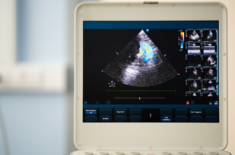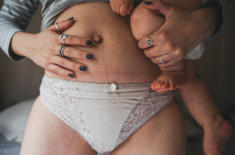How Long Should You Rest After Giving Birth?
Childbirth is physically demanding work that requires a few weeks of rest before you start to feel more “normal.”
Recovery time varies, especially between cesarean (C-section) and vaginal delivery, but it’s best to slow down and rest during the first six weeks. The recovery period for a C-section birth takes longer.
It might take 6-8 weeks for you to recover from a C-section and around 4-6 weeks for vaginal birth. However, each mom’s timeline will be different, and some moms might take longer than others. (1)(2)
What Helps Postpartum Recovery? Tips To Speed Up Healing
Rest, rest, and more rest. Plus, follow as much as you can from our checklist below.
Here’s Your Holistic Postpartum Recovery Checklist:
- Get as much sleep as you can – A good rule of thumb is to sleep whenever your baby sleeps.
- Eat well – Even if you’re too tired, make sure to eat well (especially healthy foods like whole grains, lean meat, fruits, and veggies).
- Limit visitors – Unless they’re there to help care for your baby while you rest, it’s best to limit social visits during the first six weeks.
- Avoid stair climbing (especially during the first week) – If possible, avoid climbing stairs; if you can’t help it, try to limit your trips up and down the stairs while you recover.
- Avoid heavy lifting – Try not to lift anything heavier than your baby, especially if you had a cesarean delivery. (3)
- Wash your hands – Try to reduce the risks of infection (for you and your baby) by frequently washing your hands.
- Ask for help – Don’t be afraid to tell your partner, family, or friends that you need help with caring for your baby, getting some groceries, babysitting siblings, or buying food.
- Hire a postpartum doula – They’re trained to help you transition to motherhood and can take care of your baby while you rest.
- Exercise – Although you need to wait until you’re feeling better or around six weeks postpartum, talk to your OB-GYN about your options because exercise can also help you regain muscle tone and boost circulation. (4)(5)
- Tap into gratitude – The fourth trimester is a time of rollercoaster emotions and intense sleep deprivation. In the midst of the chaos, don’t forget to take grateful moments because research shows they can help boost brain health.
- Breathe – Remember to breathe, mama. Slow, deep breathing can help you shift your mood in as little as a few minutes when you most need it.
What Happens If You Don’t Rest After Giving Birth?
It’s not a good idea to quickly bounce back to your pre-pregnancy routine even if you feel energized. It increases your risk of postpartum hemorrhage. (2)
It also slows down your recovery.
What To Expect After Birth
Some of the most common experiences to expect after childbirth: (2)(3)
- Postpartum bleeding and discharge (lochia)
- Abdominal pain
- Constipation or diarrhea
- Trouble peeing or bladder leakage (from weak pelvic floor muscles)
- Baby blues
- Hormonal shifts
- Hemorrhoids
- Perineum soreness (area between your genitals and anus)
- Sore nipples and breasts (as you adjust with breastfeeding)
- Sore or uncomfortable stitches from vaginal tears or c-section
- Weight loss or gain
- Water retention
- Postpartum hair loss
- Postpartum swelling (can affect your face, belly, legs, or ankles)
- Postpartum thyroiditis
Not all moms experience all of these. But even if you did, they rarely last beyond the postpartum period.
If you had a C-section, your recovery can take longer and also includes caring for your incision wounds. Learn more about C-section recovery in the timeline below.
Note: Don’t use tampons for postpartum bleeding because that can increase your infection risks.
Emergency Situations
Call your healthcare provider or rush to the ER if you experience any of the following:
- Signs of postpartum hemorrhage – heavy vaginal bleeding (with or without blood clots) that soaks more than one pad per hour or bleeding increases instead of decreasing with each passing day
- Vaginal discharge with a strong odor
- Passing several large clots (bigger than a quarter)
- Signs of blood clots – symptoms can include warmth, redness, tenderness, and swelling in the affected area (6)
- Increase in swelling of any body part
- Fever (over 100.4°F)
- Chills
- Signs of postpartum preeclampsia – hypertension or high blood pressure, blurred vision, and severe, persistent headache
- Fainting or dizziness
- Difficulty urinating (you can’t pass urine) or painful urination
- Heart palpitations
- Chest pain
- Difficulty breathing
- Persistent vomiting
- Red or swollen C-section incision or episiotomy (surgical cut at your vagina’s opening to help in childbirth)
- Weeping pus in your vaginal tears or C-section incision
- Worsening or new pain in your lower belly
- Engorgement – sore breasts that are red and/or feel hot to the touch
- Signs of postpartum psychosis – hallucinations, delusions, or thoughts of harming someone (yourself, your baby, or another person)
- Loss of consciousness
- Coughing up blood
- Seizures
Learn more about what you can expect per week or month in the timeline we made below.
Postpartum Recovery Timeline
One Week Postpartum
Postpartum Bleeding: How Much Is Normal After Birth?
Bleeding after childbirth is normal. It’s part of your body’s process of removing the extra materials produced and used during pregnancy. (6)
Postpartum blood, also called lochia, sometimes includes mucous membranes that lined your uterus during pregnancy. It’s heaviest up to three days postpartum. Expect bright or dark red blood up to four days from childbirth.
Lochia begins to slow down from the fourth day onwards. Expect a pinkish-brown discharge up to around 10 days postpartum.
It’s also normal to occasionally pass a few large clots (bigger than a quarter), but call your doctor if you’re soaking more than one pad per hour and there are plenty of these clots. This can be a sign of severe bleeding or postpartum hemorrhage.
Afterbirth Pains (Uterine Cramping)
Your uterus continues to contract during the first week to help stop postpartum bleeding and help it return to its normal size.
Vaginal And Perineum Healing
Aside from bleeding, your vagina and perineum (area between your genitals and anus) might feel sore or painful.
Put ice on your perineum every few hours for the first 24 hours post-birth.
Sitz baths (sitting in a warm basin of water) for around 20 minutes can help ease the pain in the area. You can do this a few times a day. Add essential oils to help speed up healing.
Spray warm water on your genitals before and after peeing. Pat dry with a clean towel or toilet paper. This helps keep urine from irritating your torn skin. Some moms like bottle sprayers like Frida Mom or even a hospital bottle.
Sleep on your side and avoid long periods of sitting or standing to help avoid putting pressure on your private parts.
C-Section Recovery
Due to your incision, movement can be difficult (including getting in and out of bed). But your doctor might encourage you to move even for just a few steps a day to help prevent blood clots. (6)
You might need to spend at least two days at the hospital after a C-section.
The staples or stitches are removed around 5-7 days later, unless your doctor wants to keep them longer for some reason or if you have dissolvable stitches. (7)
It’s important to keep your incision wound dry and clean before applying antibiotic ointment or other topical medications your doctor prescribed. Follow your doctor’s instructions to reduce infection risks.
It’s also good to avoid carrying anything heavy other than your baby.
Mood Changes (Baby Blues)
Hormone levels (e.g., estrogen and progesterone) drop shortly after birth. It’s followed by fluctuations in prolactin and oxytocin levels. These hormonal changes, plus lack of sleep and fatigue from childbirth, can lead to baby blues. (8)
Symptoms can include:
- Crying for no apparent reason
- Anxiety
- Fatigue
- Poor concentration
- Mood changes
The good news, mama, is that the baby blues usually lasts a few days and goes away without intervention.
Most new moms feel better after getting enough rest and reassurance that they’re going to be alright.
Breast Changes
Progesterone and estrogen hormone levels decline after the placenta is delivered. This signals your body to produce breastmilk, even if you aren’t planning to breastfeed. (9)
Lactation can change your breasts, with many moms describing it as a feeling of extra fullness. However, it can be especially difficult during the first week as you and your baby adjust to breastfeeding.
For breast engorgement, apply a warm compress before nursing or pumping. Then, apply a cold compress or an ice pack after each session.
You might also experience nipple pain and cracking. Try using a nipple cream to prevent or treat your sore, cracked nipples.
A nursing bra can support your heavier, milk-filled breasts and lets you nurse easier.
Hemorrhoids
Intense straining during labor can lead to hemorrhoids (swollen veins in your rectum). Apply a cold compress such as a chilled witch-hazel pad or use a sitz bath (sitting in a warm basin of water).
Bowel Movement
Vaginal delivery stretches muscles in your vagina and abdomen, but it can also affect your rectal area.
You might experience uncontrollable bowel movements or pass gas without meaning to. Fear of experiencing pain can also make it difficult to pass stool.
Avoid straining because that can open up vaginal tears or your C-section wound.
Eat plenty of fiber-rich foods (including fruits, veggies, and whole grains). Your doctor might also prescribe a stool softener.
Stay hydrated by drinking lots of water with electrolytes.
But you can also experience diarrhea due to weakened bowels.
Both are likely to resolve on their own after a few weeks. Talk to your doctor if you still experience bowel problems after a month.
Urination Pain Or Incontinence
Pressure during labor can also affect your bladder and urethra, leading to swelling or stretching. You might experience pain while urinating or have trouble holding your pee. Sometimes, you might also feel the urge to pee, but nothing comes out.
Drink plenty of water to keep you hydrated enough to pee. You can also try a sitz bath (warm water basin) or spray your genitals with water while you’re peeing.
Studies show that Kegel exercises (pelvic floor exercises) may decrease postpartum urinary incontinence. (10)(11)
Start slowly during the first week, but aim for around three sets of 20 Kegel exercises per day when you’re comfortable.
Fatigue & Body Pains
A heating pad (warm, not too hot) can help ease pain in your abdomen, legs, perineum, and back. A gentle back massage might also work wonders.
Your Post-Baby Bump
It’s normal for your tummy to look like you’re still pregnant even after delivering your baby. Your abdominal muscles were stretched a lot and can take several months to get back to pre-pregnancy size.
Exercise is beneficial for moms, but don’t attempt to exercise during your first week postpartum. Strenuous activities can increase your risk for postpartum bleeding. (12)
It’s best to rest for six weeks before exercising, but it’s also a good idea to walk a few steps each day to help prevent blood clots or swelling. (6)
Consult your OB-GYN before going back to running or doing other high-level sports and exercise activities, especially if you had a C-section or difficult delivery.
Weight Loss
Studies show that you can burn calories while breastfeeding.
Exclusively breastfeeding moms might have better chances of returning to their pre-pregnancy size than non-exclusively breastfeeding moms (mixing nursing with infant formula). (13)(14)
Parenting Concerns
Many new parents might struggle with breastfeeding and caring for their little ones, especially during the first week. Ask for help from other family members who have experience with babies.
A postpartum doula can also help with this transition. Their primary role is to focus on your well-being, but they also assist in caring for your baby and their older siblings so you can rest.
Two Weeks Postpartum
Postpartum Bleeding
For some moms, bleeding begins to taper off by this time, although they can still experience light bleeding or spotting until around four weeks.
You might notice yellowish or pinkish-brown vaginal discharge. Unless your bleeding becomes heavier or you experience postpartum hemorrhage symptoms, that’s normal.
Vaginal Birth Or C-Section Recovery
Most of your stitches are beginning to heal and are no longer painful by this time.
However, many moms experience itchiness in their vaginas or on their wounds. Thankfully, that can be a sign of healing unless it’s also accompanied by stinging pain.
Itchy Stretch Marks
You might also experience itchy skin on stretch marks that developed during pregnancy.
Some essential oils can help reduce stretch marks naturally, including bitter almond oil, lavender oil, and pomegranate oil.
Night Sweats Or Hot Flashes
Around 29% of new moms reported hot flashes or night sweats during the postpartum period, even if this is typically considered a menopausal symptom. (15)
It could be due to hormonal changes and your body’s need to shed off pregnancy fluids.
Risk factors include: (15)
- Depressive symptoms
- Obesity (higher body mass index)
Sore Nipples & Breasts
These are often due to breastfeeding concerns. It’s good to ask for help from a lactation consultant. They’ll guide you in finding ways to help your baby latch on properly.
Some ways to ease your pain:
- Finding a different nursing position
- Using a breastfeeding pillow
- Rubbing some breastmilk on your nipples
- Applying nipple cream
- Using a cotton bra shield designed to draw moisture or excess milk away from your breasts
- Air drying your nipples after each feeding session
- Avoiding harsh detergents in washing your bra
- Avoiding harsh soap to wash your breasts and nipples
Three To Six Weeks Postpartum
Overall Postpartum Recovery
You’ll need more time to recover from a cesarean section than vaginal delivery, but you might already feel better by six weeks postpartum.
Many moms are already planning to return to work at this time and go back to their exercise routines.
However, even if you’re feeling better, take it easy with your exercise and work routines. Ask for your doctor’s approval before going back to doing any form of exercise.
Postpartum Bleeding
For most moms, bleeding stops by the end of the sixth week postpartum.
Fatigue
Don’t be too hard on yourself. Fatigue is normal, even several weeks after you delivered your baby. If you feel tired, take a rest. Let your body recover.
Ask someone to help care for your baby while you’re sleeping. It’s also good to ask for help with chores around the house and taking care of older kids.
Postpartum doulas can continue to help you out, but you might also want to find a baby nurse or nanny who can focus on caring for your baby.
Parenting Concerns
You and your partner might already feel more confident and comfortable caring for your new baby by this time.
Postpartum Checkup
Even if you think you’re feeling alright, go to your postpartum follow-up checkup.
It’s usually scheduled six weeks after delivery, but the American College of Obstetricians and Gynecologists (ACOG) recommends an individualized, comprehensive postpartum checkup within the first three weeks. (16)
Your health care provider checks for the following:
- Your emotional well-being
- Infant care, breastfeeding, and other parenting concerns
- Your sleep habits
- Issues related to fatigue
- Contraception and birth spacing
Your doctor will check if these body parts are properly healing:
- Abdomen
- Vagina
- Cervix
- Uterus
- Perennial area
- Incision (if you had a C-section)
Aside from doing a physical checkup, your doctor might also check for signs of mental health concerns, particularly if you have risk factors, including a personal or family history.
Mental Health Concerns: Postpartum Depression & More
It’s important to diagnose and treat mental health concerns because they can affect your ability to care for your baby.
These issues can make you feel miserable, increase risks for risky behaviors, hinder maternal bonding, and even affect your baby’s growth and development. (17)
Talk to your healthcare provider about these mental health concerns:
- Postpartum depression
- Postpartum anxiety
- Postpartum OCD (obsessive-compulsive disorder)
- Postpartum PTSD (post-traumatic stress disorder)
- Postpartum psychosis
- Postpartum rage
- Postpartum panic disorder
Six Weeks To Six Months Postpartum
Postpartum Hair Loss
Around 20% of new mothers may experience postpartum hair loss. It happens around this time, but it’s still linked to hormonal changes after childbirth.
Bladder Control
By this time, you’re likely to have regained normal bladder control. If it remains a concern and you still leak some urine, consult your doctor. (12)
Return to Exercise
You can start exercising again with your doctor’s approval, but ask whether you can do your regular pre-pregnancy exercise routine.
Some options for postnatal exercise: (5)(12)
- Postnatal yoga
- Pilates
- Walking
- Pelvic floor exercises or Kegel exercises
- Low-impact aerobics
- Swimming or aqua aerobics (wait until at least seven days after your bleeding stopped)
- Knee bending
- Playing games with your older kids
You might already be well enough to take your baby out for a walk with you by this time.
Just make sure you use a stroller so you wouldn’t carry them while you’re out. Although baby carriers are also useful, it’s best to keep your baby’s weight off your body as much as possible while you’re recovering.
Regular Period Returns
It varies among new moms, but most women experience their period return by six months postpartum.
What’s The Six-Week Rule After Birth?
Although there isn’t an absolute rule for the waiting period on sexual activity resumption after delivery, your doctor might recommend waiting until the sixth week postpartum. (18)
Talk to your OB-GYN about your birth control options, ideally before delivery or during the postpartum follow-up checkup.
Six Months To One Year
Postpartum Hair Loss
It takes time for your postpartum hair to grow back to its pre-pregnancy state, but you aren’t likely to lose clumps of hair by the time your baby is one year old. (19)
Mental Health Status
Talk to your doctor about any lingering signs of mental health concerns, especially if you’re undergoing treatment.
C-section Healing
Your wounds are fully healed by this time, but your doctor might advise waiting for at least another year before having another baby.
You’re likely to undergo another C-section if your babies are less than 18 months apart. This reduces the risk of uterine rupture during labor and vaginal delivery.
Postpartum Weight Gain Or Weight Loss
Although breastfeeding burns calories, it’s not a guarantee that you’ll lose weight. Many moms even gain weight because they’re eating too many high-calorie foods.
Here are some ways to help you lose weight:
- Choosing a healthy diet
- Pranayama (yoga breathing techniques)
- Deep breathing
- Mindfulness
- Essential oils to support weight loss
Postpartum Recovery Tools Checklist
The following are some items you can add to your hospital bag checklist or essentials for postpartum care and recoveryat home:
- Maxi pads (don’t use tampons) – You’ll need these for at least a few weeks.
- Ice packs – To ice your perineal area.
- Witch hazel pads – To help ease vaginal pain and postpartum hemorrhoids.
- Herbal perineal spray – You can use a squirt bottle for perineum cleaning.
- Sitz bath – Small tub for soaking sore your perineum or rectum (for hemorrhoids)
- Heating pad – It can help ease pains in your breasts and tummy; just be careful that it isn’t too hot.
- Stool softener – Your doctor might prescribe this for the first week after delivery so you won’t strain while pooping.
- Cotton panties – Hospital gauze underwear or “granny” panties can be a more comfortable choice, especially on the first few days after delivery.
- Nursing bras – These can support your fuller breasts and make breastfeeding easier because you won’t need to take off your bra. You just open the flaps.
- Nipple cream – It helps prevent and treat cracked, sore nipples.
- Nursing pads or shields – These keep moisture and excess milk away from your nipples and your clothes from becoming wet.
- Postpartum recovery belt – It provides support to your belly as it shrinks back to its pre-pregnancy size. It’s especially helpful after a C-section.
- Breastfeeding pillow – It helps you and your baby find a good position for your feeding session.
- Breast pump – It helps you collect breastmilk for storing, establishing your milk supply, or easing engorgement.
What Partners & Family Members Can Do
Some ways you can help someone during postpartum recovery:
- Volunteer to care for the baby so they can sleep.
- Volunteer to care for older siblings and other dependents.
- Provide or buy healthy meals.
- Keep the house clean and safe.
- Do chores, such as shopping for groceries, doing laundry, or throwing out the trash, because these can be physically strenuous to a mom who just gave birth.
- Ensure she has all the medications and supplies needed to treat her C-section wounds or vaginal tears.
- Provide emotional support.
- Check for any signs of postpartum depression or other mental health conditions.
- Help the new mom find support and treatment.
- Ask what she needs and make her feel good about herself and her baby.
REFERENCES
(1) https://health.clevelandclinic.org/c-section-recovery/
(2) https://my.clevelandclinic.org/health/articles/9679-postpartum-care
(3) https://www.hopkinsmedicine.org/health/wellness-and-prevention/what-really-helps-you-bounce-back-after-pregnancy
(4) https://www.nwh.org/patient-guides-and-forms/postpartum-guide/postpartum-chapter-2/exercise-after-delivery
(5) https://www.nct.org.uk/life-parent/your-body-after-birth/postnatal-exercise-how-soon-can-i-start-again-after-baby
(6) https://utswmed.org/medblog/blood-clots-after-delivery/
(7) https://www.tommys.org/pregnancy-information/giving-birth/caesarean-section/recovering-home-after-c-section
(8) https://www.marchofdimes.org/pregnancy/baby-blues-after-pregnancy.aspx
(9) https://www.sciencedirect.com/topics/agricultural-and-biological-sciences/human-lactation
(10) https://www.jogc.com/article/S1701-2163(16)30310-3/fulltext
(11) Nygaard IE, Kreder KJ, Lepic MM, Fountain KA, Rhomberg AT. Efficacy of pelvic floor muscle exercises in women with stress, urge, and mixed urinary incontinence. American Journal of Obstetrics and Gynecology. 1996 Jan;174(1 Pt 1):120-5. doi: 10.1016/s0002-9378(96)70383-6. PMID: 8571994. https://www.ajog.org/article/S0002-9378(96)70383-6/pdf
(12) https://www.pregnancybirthbaby.org.au/safe-return-to-exercise-after-pregnancy
(13) https://jhu.pure.elsevier.com/en/publications/effects-of-breastfeeding-on-postpartum-weight-loss-among-us-women-4
(14) https://experts.umn.edu/en/publications/association-of-full-breastfeeding-duration-with-postpartumweight-
(15) https://www.fertstert.org/article/S0015-0282(13)02967-1/fulltext
(16) https://www.ndlegis.gov/assembly/67-2021/testimony/HHUMSER-4002-20210317-9353-F-ROERS_KRISTIN.pdf
(17) https://www.researchgate.net/publication/332760284_Consequences_of_maternal_postpartum_depression_A_systematic_review_of_maternal_and_infant_outcomes
(18) https://www.nct.org.uk/life-parent/sex-after-baby/sex-after-baby-10-questions-ask-yourself
(19) https://www.researchgate.net/publication/335301453_Telogen_effluvium_a_comprehensive_review












